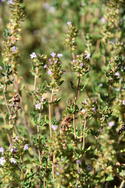Propagation

Planting Method
Large scale seeding directly into the plant area is done by mechanical planters. Planting by large commercial growers is more commonly done by planting thyme seedlings that have been produced in a greenhouse.
This gives the grower more control of the plant density and uniformity. The thyme seeds are planted into seedling trays about 6 mm deep. Once the seeds have germinated and strong seedlings have grown, these are planted out into the field.
Spacing
Thyme plants should be spaced 20 cm apart in rows that are 50 cm apart. This is a stand of around 80 000 plants per hectare. Implement and tractor paths are left for management practices and harvesting.Sowing Time
Direct sowing of thyme is done into the field in autumn. In South Africa, this will be in late March or early April and ensures that the seedlings develop before the winter and that by spring they are strong and well established.
Sow seeds into seed trays in a protected environment or greenhouse during June and by early spring the thyme seedlings should be strong enough to plant out into the fields. Seedlings are normally strong enough to plant eight weeks after planting seeds.
Planting Time
Plant the thyme seedlings in early spring.
In South Africa plant seedlings in late August to early September after the last frost.
Growth Period
Eight weeks in the greenhouse should produce strong thyme seedlings that are ready to plant out into the fields. For fresh thyme production, some producers start harvesting the fresh growth tips from as early as 12 weeks from planting out. Thereafter a second harvest can be done before autumn. The second year of harvesting will yield more cuts.
Thyme plants can be harvested for four to five years if managed properly. Thyme plants become very woody and brittle as they get older so it is advisable to replace the plants every four to five years.
Fertilization
Thyme does not require a lot of fertilizer. Before planting, a representative soil sample should be taken and sent for analysis. This will identify soil type and nutrient requirements for the intended crop. For a rough guide, the following recommendation can be used in the absence of soil analysis.
An initial 250 kg application of 3:1:5 can be broadcast and incorporated into the top 20 cm of soil prior to planting the seedlings. This will give the new thyme seedlings a good start in establishing themselves.
During the first 12 months, it is important to keep the plants growing so a further two applications of 200 kg of 3:1:5 can be applied along the plant rows, one in December and another in March. It is advisable to fertilize after every harvest cut.
Irrigation
The thyme plant is a hardy plant and does not require a lot of water. If planted without permanent irrigation, a rainfall of about 500 mm over the year should be sufficient. Installing permanent irrigation does however increase yields. Overhead or drip irrigation is suitable but do not over-irrigate as this causes root diseases and reduces the potency of the essential oils in the plant.
Depending on soil types and the weather, irrigation volumes will differ from field to field. A good average is between 20 and 25 mm per week during the warm summer months and reducing during cooler or rainy months of the year.
Do not irrigate the week before harvest, but irrigate immediately after harvest to bring soil back to optimum moisture levels to minimize stress. It is advisable to install moisture monitoring devices to continuously monitor the soil.